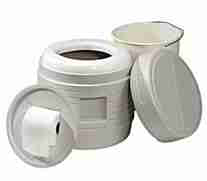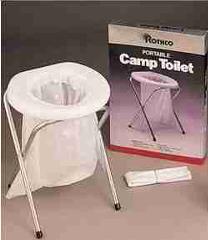 Disaster zone & Emergency toilets
Disaster zone & Emergency toilets
- POST a QUESTION or COMMENT about Toilets for use in an emergency or disaster zone: flushing methods, toilet alternatives, plastic bags, buckets, sanitation concerns
Emergency-use toilets & disaster zone toilet options.
This article describes how to make an emergency toilet in a disaster zone or how to flush existing toilets in an emergency. Emergency services needed in area of flood, hurricane, storm, & wind damage control & building inspection include ways to provide toilet facilities.
This article gives options including possible use of building toilets or various makeshift toilets and sanitary facilities that can be used if there are not other or no better toilet facilities available in an emergency or in a disaster zone such as following a flood, hurricane, or earthquake.
InspectAPedia tolerates no conflicts of interest. We have no relationship with advertisers, products, or services discussed at this website.
- Daniel Friedman, Publisher/Editor/Author - See WHO ARE WE?
Emergency Toilet Flush Methods, Disaster Zone Toilets, & Camping or Portable Toilets
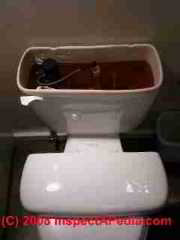 Question: Disaster zone toilet guide - emergency toilet flushing procedure & alternatives - can I use lake water to flush toilets?
Question: Disaster zone toilet guide - emergency toilet flushing procedure & alternatives - can I use lake water to flush toilets?
Post hurricane sandy question:
Can I use lake water to flush my toilets. We still have no power, heat or water in Stamford, Connecticut - S.D., Stamford CT 11/5/2012
Reply: Suggestions for emergency flush procedures for conventional toilets when heat, electricity, or water are not available
Here are some suggestions for & warnings about using lake water or other reasonably-clean water from other sources to flush toilets in an emergency.
In short, S.D. yes you can use lake water to flush a toilet. Rather than living with un-flushed toilets, you can use lake water, snow melt, rainwater collected at a downspout, etc. to flush conventional water type toilets (or urinals or bidets) in a building connected to a public sewer or private septic system.
But be sure to read our warnings and procedures (next) that may help avoid a mess.
Watch out: If you know that your public sewer or private septic system is still flooded or under water, do not try flushing water type toilets in the building or you will probably find that the toilet will overflow into the building.
Watch out: even if your septic system is itself is no longer visibly flooded, nevertheless the septic tank may have become flooded, even filled with mud and silt, and the drainfield may still be saturated - meaning that there is still a significant risk of a sewage backup into your building when you try flushing a toilet.
See SEPTIC SYSTEM FLOOD REPAIR for procedures for checking out and repairing a septic tank that has been flooded.
When Can You Safely Flush Building Toilets After a Flood, Hurricane, Etc.
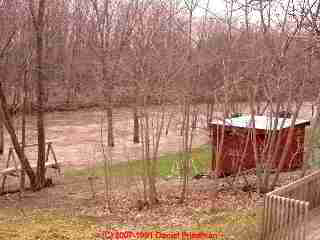 If you are pretty sure your septic tank and fields are at least not under water, or that the public sewer is no longer under water and flooded, you can test the private or public sewer system to see if you can safely begin flushing toilets:
If you are pretty sure your septic tank and fields are at least not under water, or that the public sewer is no longer under water and flooded, you can test the private or public sewer system to see if you can safely begin flushing toilets:
- Select water that is free of debris and is clean as you can (it does not have to be sanitary, clear lake water would be fine) - don't use water loaded with weeds or other trash to flush a toilet as you risk clogging the drain system.
- Test a lowest-floor sink or tub drainage first: try pouring a few gallons of clean lake water (no weeds etc) down a bath tub drain or sink drain on your lowest floor. If that drain doesn't back up and no water comes up in nearby drains (floor drains, sink, shower, tub), then
- Test a toilet on the lowest floor next: try flushing the lowest toilet in the building - you can fill the toilet tank to the fill line and then flush, or (messier) you can try pouring some water directly into the toilet bowl until it begins to flush.
We chose a toilet on lowest floor to avoid the unpleasant surprise of flushing an upper floor toilet only to see the sewage boil up out of a lower floor toilet in the building.
Watch out: if you flush via the toilet tank and flush valve and the toilet starts to back up or overflow, quickly
- Take off the toilet tank lid and carefully (not to break it) place it aside
- Manually push closed the toilet flush valve in the center bottom of the toilet tank to stop the flush
- See TOILET OVERFLOW EMERGENCY for illustrated details of this emergency procedure to stop an overflowing toilet
Other emergency toilet options for use when your home or building have no power, water, etc. include these expedient methods for holding feces, toilet paper, and if necessary, urine
- Use existing portable toilets already in your area? Check with local emergency services and neighbors to see if emergency personnel have already set up portable toilets close to your home or building.
If so, you may want to use those toilets, or you may want to use them to dispose of the waste collected in your own emergency toilet such as the alternatives we describe here.
In the event that there are no public toilets or sanitary facilities working nearby or simply for convenience if there are those who need to make frequent use of an indoor toilet during an emergency, one of the disaster-toilet methods described below may work for you.
- Camping toilets or porta-potties: illustrated above and described in detail at
at CAMPING & EMERGENCY TOILETS
such as portable johns, port-a-potties if you can obtain one of these devices; if possible, also pick up some chemical deodorant to use if the type of portable toilet you can find makes use of such chemicals. - Home made emergency toilet: any container, a plastic trash can, even a metal ammunition box (described in the article just above) can be used as an emergency toilet. Line the "toilet" with a plastic bag that can be closed and later carried to an appropriate waste disposal site.
Exact details of using a small container as an emergency toilet can be read
at ARMY SURPLUS AMMO BOX EMERGENCY TOILET box or ammunition can for an emergency field toilet.
Watch out: Emergency toilet tip #1 - especially for children, elderly or disabled, if you are using a plastic-bag-lined bucket as an emergency toilet, it would be smart to locate it in a corner where there are railings or heavy furnishings that can assist people in sitting down and getting up off of the makeshift toilet. - A plastic zip-lok or similar sealable bag can, with some care, be used to catch feces, toilet paper, as needed. Typically these are a one-use per person per bowel movement solution.
After using, place the used toilet paper in the bag with the excrement. See our tip about bleach or disinfectant immediately below.
Squeeze out excess air before closing the bag. In an emergency situation where you must make use of disposable bags to serve as a toilet, collect the bags in a larger plastic garbage bag, doubled if necessary for strength, in order to provide a sanitary means of later carrying the waste to a suitable disposal location.
Do not dispose of waste by leaving it on the ground exposed to weather where runoff may contaminate public surfaces, streets, or nearby water sources.
Definition of flying toilets: in some areas where people live in crowded urban conditions with no public sanitation (such as the Kiberia Slums, East Africa's largest informal settlement), the frequent use of plastic bags as emergency or even regular use toilets has led to the popular term flying toilets - a reference to the practice of tossing the plastic bag of waste into a nearby vacant lot or onto a nearby rooftop. [9]
Watch Out: Emergency toilet tip #2 - avoid burst or exploding sealed plastic bags of feces: seal the plastic bag after use as an emergency and store it in a cool dry place if possible, inside of a larger plastic trash bag to await proper disposal.
If you have bleach or a similar disinfectant, mix your bleach as one part bleach to three parts water and pour a few tablespoons into the plastic bag before sealing it - this will reduce bacterial action and gas formation and might avoid a burst bag.
Emergency toilet tip #2 - Provide a bucket of clean water and soap for washing hands, something that will be particularly appreciated if people have to try using a small plastic bag as a temporary toilet.
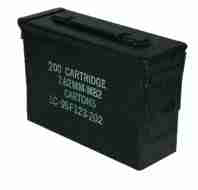
...
Reader Comments, Questions & Answers About The Article Above
Below you will find questions and answers previously posted on this page at its page bottom reader comment box.
Reader Q&A - also see RECOMMENDED ARTICLES & FAQs
Question: emergency toilet option during COVID Pandemic - septic system failed
2020/05/13 Steve H said:
Hi! I have a 30 year old septic system serving our 3 bedroom house.
About 2 months ago we had the tank pumped and inspected as we got back flow into the downstairs tub and toilet. It was indicating that our drain field has failed. We are in the process of getting a new Glendon system installed, however with Covid and the county permitting, it’s expected to be at least 4 more weeks until we’re back online.
We’ve been extremely conservative in our water use to limit as much as we can more stress in the already failed drain field, but after a few days of heavy rains, we’re back to water being above the outlet pipe and 1/4” above the bottom lip of the inlet, close to where we were when we got the back flow.
What can I do besides rent a hotel for the next 4 weeks to get by until the new system is installed?
Would it be worthwhile to pay the 900 bucks I was quoted to pump the tank empty and “jet the lines” Considering having no functional water in essence for 2 kids and 2 adults in quarantine for 4 weeks sounds like a nightmare?
This Q&A were posted originally
at SEPTIC DRAINFIELD FAILURE DIAGNOSIS
Moderator reply: more emergency & temporary toilet solutions
Thanks for the question, Steve.
I'm doubtful that jetting the drainfield works for long, though with some processes like Terralift you might get temporary help.
An alternative is water conservation and tank pumping.
How big is your septic tank? And whats the charge to empty it weekly vs other options?
What climate? If not too cold, then consider these additional options
- A rental Portapotty or even
- Rental RV complete with a shower and toilet is an option. The RV will have its own holding tank that you can empty periodically by driving to a dumping station or campground - though most of those are closed during the COVID-19 pandemic
- Chemical toilet - if you have an accessible, nearby dumping station you can use. Some of these are very simple, even rudimentary.
See ALTERNATIVE & WATERLESS TOILETS
See CHEMICAL TOILETS - A temporary latrine can work for some families, though with small children, use at night may be a hassle
See OUTHOUSES & LATRINES - The woods - if you live in a sufficiently rural area, same objection as for latrines
Also, please see our suggestions for emergency toilets at
...
Continue reading at CAMPING & EMERGENCY USE TOILETS or select a topic from the closely-related articles below, or see the complete ARTICLE INDEX.
Or see these
Related Articles
- ALTERNATIVE & WATERLESS TOILETS camping toilets, chemical toilets, emergency-use toilets, waterless toilets, graywater systems, composting toilets, home health care toilets, incinerating toilets, outhouses, and latrines
- CAMPING & EMERGENCY USE TOILETS
- CHEMICAL TOILETS
- DISASTER ZONE TOILET GUIDE
- EARTHQUAKE DAMAGE - home
- FIRE DAMAGED BUILDINGS - home
- FLOOD DAMAGE CLEANUP & REPAIR GUIDE - home
Suggested citation for this web page
DISASTER ZONE TOILET GUIDE at InspectApedia.com - online encyclopedia of building & environmental inspection, testing, diagnosis, repair, & problem prevention advice.
Or see this
INDEX to RELATED ARTICLES: ARTICLE INDEX to TOILET INFORMATION
Or use the SEARCH BOX found below to Ask a Question or Search InspectApedia
Ask a Question or Search InspectApedia
Try the search box just below, or if you prefer, post a question or comment in the Comments box below and we will respond promptly.
Search the InspectApedia website
Note: appearance of your Comment below may be delayed: if your comment contains an image, photograph, web link, or text that looks to the software as if it might be a web link, your posting will appear after it has been approved by a moderator. Apologies for the delay.
Only one image can be added per comment but you can post as many comments, and therefore images, as you like.
You will not receive a notification when a response to your question has been posted.
Please bookmark this page to make it easy for you to check back for our response.
IF above you see "Comment Form is loading comments..." then COMMENT BOX - countable.ca / bawkbox.com IS NOT WORKING.
In any case you are welcome to send an email directly to us at InspectApedia.com at editor@inspectApedia.com
We'll reply to you directly. Please help us help you by noting, in your email, the URL of the InspectApedia page where you wanted to comment.
Citations & References
In addition to any citations in the article above, a full list is available on request.
- [1] REPAIRING YOUR FLOODED HOME [PDF], American Red Cross & FEMA: Federal Emergency Management Agency, FEMA PO Box 2012, Jessup MD 20794-2012. Printed copies of this book are available from the American Red Cross, from your local Red Cross chapter, or by writing to the address above. Web search 10/4/2010, original source: http://www.redcross.org/www-files/Documents
/pdf/Preparedness/file_cont333_lang0_150.pdf - [2] The following are available free from:
Federal Emergency
Management Agency
Attn: Publications
P. O. Box 2012
Jessup, MD 20794-2012
- Design Manual for Retrofitting Flood-prone Residential Structures, FEMA-114. This detailed manual explains all the floodproofing options in language a homeowner can understand.
- Elevated Residential Structures, FEMA-54.
- Floodproofing Non-residential Structures, FEMA-102.
- Coastal Construction Manual, FEMA-55.
- Manufactured Home Installation in Flood Hazard Areas, FEMA 85.
- [3] The following are available for
free from:
U.S. Army Corps of Engineers
Attn: CECW-PF
20 Massachusetts Avenue, NW
Washington, D.C. 20314
- Introduction to Flood Proofing, John R. Sheaffer, 1967
- Flood-Proofing Regulations, U.S. Army Corps of Engineers, Pittsburgh District, 1990, 80 pages (Corps publication EP 1165 3 314).
- Flood Proofing Systems & Techniques, L.N. Flanagan, editor, 1984
- Flood Proofing Tests, Tests of Materials and Systems for Flood Proofing Structures, Corps of Engineers, National Flood Proofing Committee, August, 1988.
- Raising and Moving the Slab- On-Grade House, Corps of Engineers National Flood Proofing Committee, 1990.
- [4] The following publications are
available from the American Red
Cross. Contact your Red Cross
chapter for more information:
- Your Family Disaster Plan (ARC 4466)
- Su plan para el hogar en caso de desastres (ARC 4466S)
- Your Family Disaster Supplies Kit (ARC 4463)
- Su Equipo de suministros para la familia en caso de desastres (ARC 4463S)
- Safe Living in Your Manufactured Home (ARC 4465)
- Are You Ready for a Flood or Flash Flood? (ARC 4458)
- ¿Está preparado para una inundación or inundación súbita? (ARC 4458S)
- Are You Ready for a Hurricane? (ARC 4454)
- ¿Está preparado para un huracán? (ARC 4454S)
- [5] Clean up References Many Cooperative Extension Service offices have home economists and food and farm experts. Check your telephone book under the county name. For example, if you live in Pittsburg County, check under “Pittsburg County Cooperative Extension Service”.
- [6] Questions on cleaning or disinfecting of specific materials can be answered by manufacturers of cleaning products. Check the product labels for toll free telephone numbers.
- [7] References on technical aspects of floodproofing can be located through the Floodplain Management Resource Center, a free service provided by the Association of State Floodplain Managers. Call 303/492-6818
- [8] CMHC, Canadian Mortgage and Housing Corporation, "After the Flood — A Homeowner’s Checklist", retrieved 10/21/2012, original source http://www.cmhc-schl.gc.ca/en/co/maho/em/em_001.cfm [copy on file as After_The_Flood_CMHC.pdf]
- [9] BBC News, "In pictures: Flying toilets", retrieved 12/30/12, original source: http://news.bbc.co.uk/2/shared/spl/hi/picture_gallery/07/africa_flying_toilets/html/1.stm
- Ammo cans or military surplus ammunition boxesare widely available
.30 Cal USED Metal Ammo Can - Used, Fair Condition. Original US Military Surplus. 200 Cartridges. 7.62 MM, M13, Overhead Fire, 1 M62 .4 m80 lc-87J601l368 Printed On Front Of Ammo Can. Dimensions: 10.25" x 6.5" x 3.5". GSA Compliant. - The Century 6205 2.6-Gallon Portable Toilet> by Century Tool shown in the photograph at page top was purchased at Amazon.com and costs less than $100. Other Century Tool camping products can be seen at centurycamping.com/
- Coleman Corporation, 3600 North Hydrauli, Wichita, KS 67219, Tel: 1-800-835-3278, is a producer of camping equipment and gear, including chemical and portable toilets including both non-flush portable toilets and a large portable flush-toilet. Coleman has offices in many countries.
- Reliance Products, 1093 Sherwin Road, Winnipeg, MB, Canada R3H 1A4, Toll Free: 1-800-665-0258, Telephone: (204) 633-4403, produces the Reliance Hassock Portable Toilet #00984421. Quoting from the company's website:
Whether you’re on the road, in a campground, out on the water, or at the cabin, the Hassock is one of best portable toilets around. This lightweight, self-contained toilet has a comfortable contoured seat, a removable inner bucket for easy waste disposal and clean-up, an inner splash cover, and toilet paper holder.
In addition, the Hassock is compatible with our standard Double Doodie bag, which means virtually no clean-up and waste disposal is a snap when used together. - Rothco Corporation, 3015 Veterans Memorial Highway, Ronkonkoma, New York 11779-0512, Telephone: 631-585-9446, Toll Free: 800-645-5195
Domestic Fax: 631-585-9447, International Fax: 631-585-9442,
Email: info@rothco.comTel. 800-645-5195; Rothco, founded in 1953, is a wholesale supplier of military and outdoor products including camping toilets. Quoting:
ROTHCO is America’s foremost wholesale supplier of military and outdoor products. We carry an extensive line of apparel and gear available for domestic and overseas sale to resellers of all types: retail, wholesale, military, police, security, outdoor products, screen printers, uniform dealers, fashion retailers, and sportswear shops. For nearly 50 years we’ve primarily serviced independently-owned Army/Navy surplus stores across America, but in recent years ROTHCO has expanded our customer and product range to include new lines of sportswear and over 25% of our sales are now to overseas customers. - Thetford Corporation 7101 Jackson Road, Ann Arbor, MI 48103, Phone: 1-800-543-1219, 734-769-6000, Fax: 734-769-2023; Thetford produces a wide range of permanent and portable alternative toilet designs. Quoting:
Our [toilet] products are easy to use at bedside and indispensable for the physically challenged, the aged, and small children.
Thetford's list of toilet products suitable for home or bedside health care are listed at
http://www.thetford.com/Thetford/HOME/ApplicationHome/BedsideApplications/tabid/94/Default.aspx - Our recommended books about building & mechanical systems design, inspection, problem diagnosis, and repair, and about indoor environment and IAQ testing, diagnosis, and cleanup are at the InspectAPedia Bookstore. Also see our Book Reviews - InspectAPedia.
- In addition to citations & references found in this article, see the research citations given at the end of the related articles found at our suggested
CONTINUE READING or RECOMMENDED ARTICLES.
- Carson, Dunlop & Associates Ltd., 120 Carlton Street Suite 407, Toronto ON M5A 4K2. Tel: (416) 964-9415 1-800-268-7070 Email: info@carsondunlop.com. Alan Carson is a past president of ASHI, the American Society of Home Inspectors.
Thanks to Alan Carson and Bob Dunlop, for permission for InspectAPedia to use text excerpts from The HOME REFERENCE BOOK - the Encyclopedia of Homes and to use illustrations from The ILLUSTRATED HOME .
Carson Dunlop Associates provides extensive home inspection education and report writing material. In gratitude we provide links to tsome Carson Dunlop Associates products and services.


